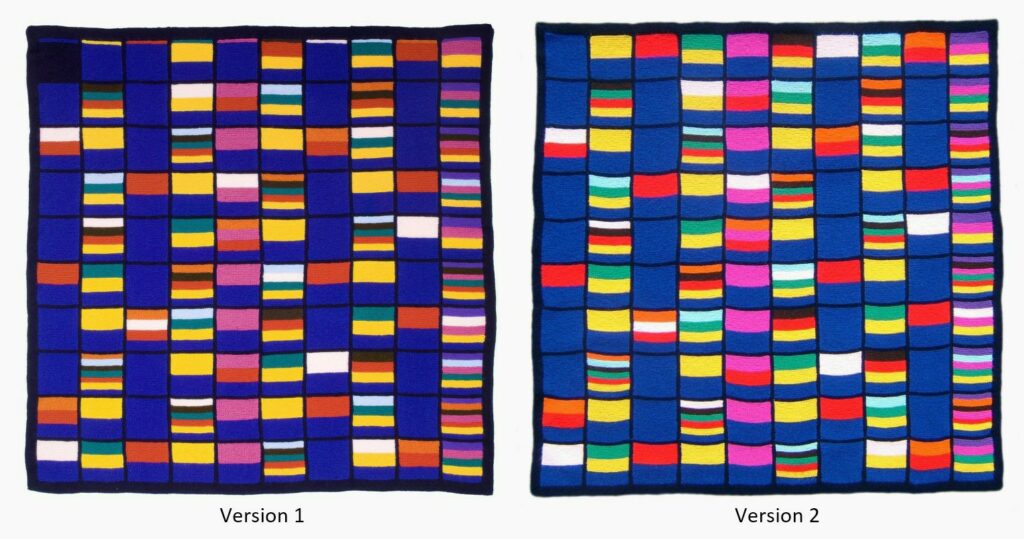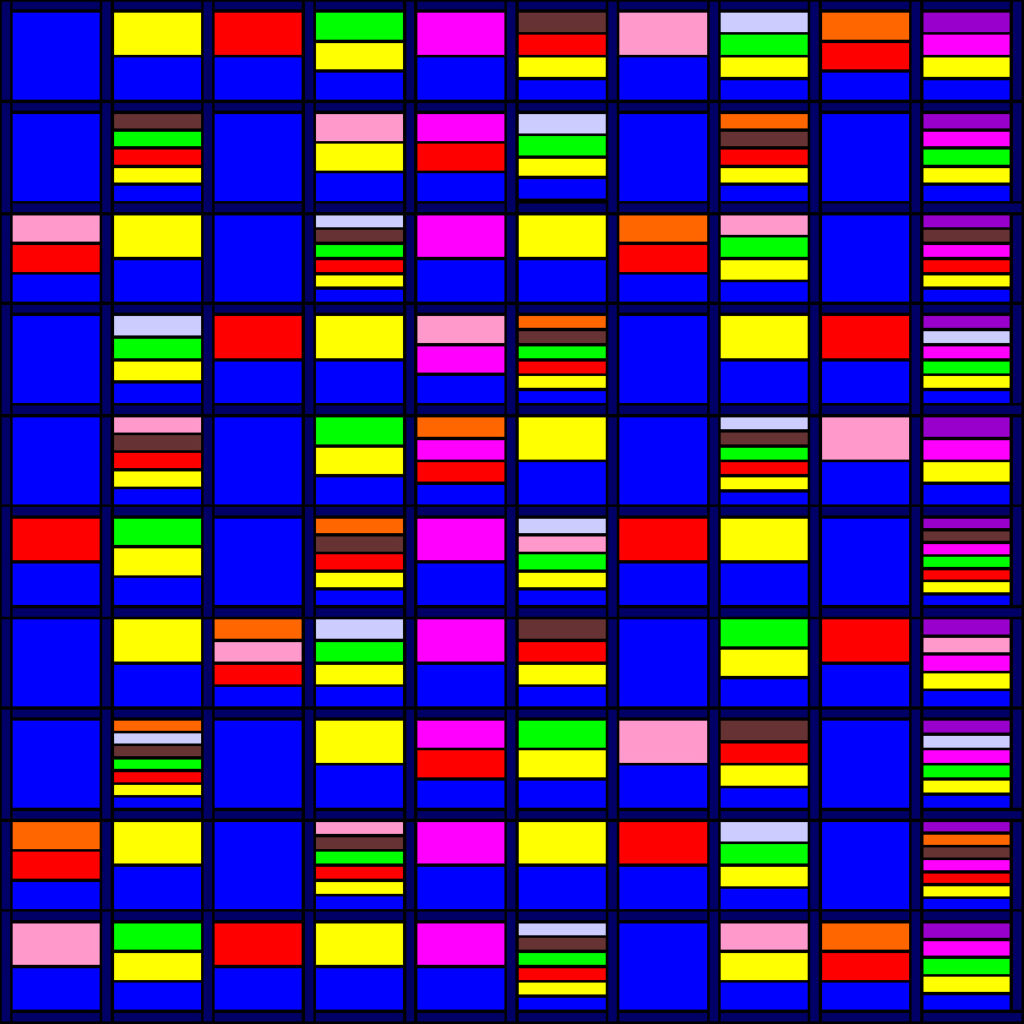The Big Lock-Down Math-Off, Match 9
The Aperiodical 2020-04-27
Welcome to the ninth match in this year’s Big Math-Off. Take a look at the two interesting bits of maths below, and vote for your favourite.
You can still submit pitches, and anyone can enter: instructions are in the announcement post.
Here are today’s two pitches.
Pat Ashforth and Steve Plummer – Counting Pane
Pat Ashforth and Steve Plummer explore maths through knitting and crochet at woollythoughts.com.

It may not be immediately obvious what this represents. You might get a clue if you ask yourself why you see yellow stripes in alternate columns but nowhere else. Why do some columns have so few colours?
The blanket is called Counting Pane. It has 100 squares in 10 rows. The first row represents the numbers 1 to 10, the second is 11 to 20, and so on. The colours across the top represent factors (or divisors, or whatever you want to call them). Blue stands for 1, yellow stands for 2, red is 3, green is 4, pink is 5, brown is 6, light pink is 7,light blue is 8, orange is 9, and purple is 10.
Before you read on, ask yourself some questions about what jumps out at you. Here are some you might like to think about:
- Why are there so many plain blue squares?
- Why are there so many light-blue/yellow/green squares?
- Why is the end column so crowded?
There were questions and problems, at the designing stage. The first was that there were more factors than we had thought about and we couldn’t possibly include them all. No factors above 10 are included because there simply wouldn’t be room for more. Also, and more importantly, the colours had to be easy to identify. It had to be immediately obvious which was which.
Another problem was working out what size the squares must be to fit in the different numbers of stripes. We went for twenty-four ridges of knitting in each square. This worked for squares with 1, 2, 3, 4, or 6 colours and I only had to cheat a little where we needed 5 or 7 colours.
Making this blanket was a shock. I had assumed I knew most of what one could ever know about the numbers up to one hundred but there was far more there than I had anticipated
What struck me first was the large number of colours in the tens column. I must have known that as I was knitting it but it only jumped out when it took its place with the other columns. I have often been known to talk about ‘nice numbers’. To me, nice numbers are those that have lots of factors because they are easy to juggle with. I had never classed multiples of ten as nice numbers. They were ‘just tens’. Everyone knows you add a nought if you want to multiply by ten or take one off if you want to divide. That didn’t make them interesting enough to be ‘nice numbers’. Now they were the first thing to shout at me. That column was far more colourful than any of the others. There were more factors than anywhere else.
The blue/yellow/green squares also seemed to stand out. It is obvious, when you stop to think about it, that any number that will divide by 4 also divides by 2. Everywhere there was a green stripe representing 4, there would be a yellow stripe. Similarly, every square containing light blue, for 8, must also have green and yellow. A brown 6 always went along with a yellow 2 and a red 3.
Oranges, representing multiples of 9, made an interesting sloping line. We could have expected this because adding 9 is the same as adding 10 and taking away 1 so the squares are one away from lining up. We hadn’t expected the lines of red that seemed to criss-cross in all directions. Bright pink only appeared in two columns but, as it represented 5, perhaps that was not so surprising.
The other big surprise, that changed my perception of certain numbers, was the number of plain blue squares. All the plain blue squares are primes but not all of the primes are plain blue. 2, 3, 5, and 7 are all prime numbers but they have a coloured stripe. However, what was very apparent was that the blue squares were clustered in certain columns. Whenever I think about prime numbers now I think about them in terms of which column they are in. We have made three versions of Counting Pane. The first was bought by the Science Museum (London). It is slightly different from the others because we tried to resolve the problem of 1 looking like a prime number when technically it isn’t. For versions two and three we decided this was an anomaly we would have to live with and introduce as a discussion point when appropriate. Versions 2 and 3 have other slight cosmetic differences (including at the tops of the columns).

At the most basic level this afghan offers a very graphic way for children to understand the difference between odd and even and to realise that this is really the same as knowing whether a number divides by 2. Yellow only appears in half of the columns. These columns contain only even numbers.
Numbers which divide by 5 are also spotted quickly, by young children, as raspberry is noticeably only in the 5’s and 10’s columns. Putting these two ideas together there is only one column with yellow and raspberry so this must be the column of 10’s. There are many questions that can be asked. I could go on and on. The more you look the more you will see.

More than twenty years ago we provided resources for using this design in schools. Some of them are lost but others are cobbled together in a file to download and use. It includes a colouring-in sheet www.woollythoughts.com/information/countingpane.html
(If you are old enough to remember the days when bedspreads were called counterpanes, the title will make more sense.)
Nikki Rohlfing – The Phoenix Number
Nikki Rohlfing is a heavy metal roadie turned maths teacher. On twitter he is @heavymetalmaths.
What is your favourite number? Surely everyone has one, and Alex Bellos even did a survey to see which number is the most favourite in the world (or at least from the 30,025 submissions he got).
Spoiler: it was 7.
If you ask me though, at a glance, I’d say 6, it’s just, y’know, so perfect…..b’dum. Also hexagons are awesome, and the more personal reason of wearing the number 6 shirt when scoring my first football goal for school. Being half German, I can also provide a somewhat low-brow reason as well for why I like 6….
However, if giving it some thought, then despite a range of impressive numbers out there, I will not go with 6, but rather a 6 digit number instead; The Phoenix Number: $142857$.
So what’s so special about $142857$? Well, here’s a start:
\begin{align} 1\times\color{red}{1}\color{orange}{4}\color{green}{2}\color{blue}{8}\color{darkblue}{5}\color{purple}{7}&=\color{red}{1}\color{orange}{4}\color{green}{2}\color{blue}{8}\color{darkblue}{5}\color{purple}{7} \\ 2\times\color{red}{1}\color{orange}{4}\color{green}{2}\color{blue}{8}\color{darkblue}{5}\color{purple}{7}&= \quad \color{green}{2}\color{blue}{8}\color{darkblue}{5}\color{purple}{7}\color{red}{1}\color{orange}{4} \\ 3\times\color{red}{1}\color{orange}{4}\color{green}{2}\color{blue}{8}\color{darkblue}{5}\color{purple}{7}&=\enspace \color{orange}{4}\color{green}{2}\color{blue}{8}\color{darkblue}{5}\color{purple}{7}\color{red}{1} \\ 4\times\color{red}{1}\color{orange}{4}\color{green}{2}\color{blue}{8}\color{darkblue}{5}\color{purple}{7}&=\qquad \color{darkblue}{5}\color{purple}{7}\color{red}{1}\color{orange}{4}\color{green}{2}\color{blue}{8} \\ 5\times\color{red}{1}\color{orange}{4}\color{green}{2}\color{blue}{8}\color{darkblue}{5}\color{purple}{7}&=\qquad\enspace \color{purple}{7}\color{red}{1}\color{orange}{4}\color{green}{2}\color{blue}{8}\color{darkblue}{5} \\ 6\times\color{red}{1}\color{orange}{4}\color{green}{2}\color{blue}{8}\color{darkblue}{5}\color{purple}{7}&=\quad\enspace\color{blue}{8}\color{darkblue}{5}\color{purple}{7}\color{red}{1}\color{orange}{4}\color{green}{2} \end{align}
I only came across it about 5 years ago, and definitely hit a “wow” factor with me when seeing that!

So obviously, the question is what happens next? It’s a 6-digit number, and we’ve had all the 6 possible permutations? Well….
\[7\times\color{red}{1}\color{orange}{4}\color{green}{2}\color{blue}{8}\color{darkblue}{5}\color{purple}{7}\color{black}=999999\]
It explodes! But then, just like the phoenix, it comes back again. Although because you then get a number with more than 6 digits, there’s a little additional work to get back to a permutation. For example,
\[815\times\color{red}{1}\color{orange}{4}\color{green}{2}\color{blue}{8}\color{darkblue}{5}\color{purple}{7}\color{black}=116428455\]
What you do now is, counting from the units, get a 6-digit number, and whatever digits are before that create a new number. These you then add together. So in the case above, you would have $428455$ as the 6 most right digits, and it leaves 116 in front. So you compute $428455 + 116 = \color{orange}{4}\color{green}{2}\color{blue}{8}\color{darkblue}{5}\color{purple}{7}\color{red}{1}$.
What if there are more than 6 digits in front of the far most right 6 digits I hear you ask? Well, you just repeat the above process until only 6 digits are left, and you will get a permutation of the Phoenix Number (if not itself). Magic!
And if that’s not enough of a wow, here’s a couple of small bonuses:
Splitting the number up into two 3 digit numbers: Then $857^2-142^2=\color{purple}{7}\color{red}{1}\color{orange}{4}\color{green}{2}\color{blue}{8}\color{darkblue}{5}$.
(Is it just me, or does the difference of two squares somehow pop up everywhere?)

Also:
\[14+28+57=99 \qquad\qquad 142+857=999\]
Even 4 digits works, if you allow a bit of a cycle and therefore also ensuring each number appears an equal amount of times for fairness:
$1428+5714+2857=9999$ and this carries on for 5 digits, 6 digits etc.
Speaking of cycle, $142857$ is in fact an example of a cyclic number. There are quite a few out there, the next has 16 digits, so they get quite long quite fast! As you’d expect, the OEIS lists them: https://oeis.org/A004042.
So what makes it cyclic? Well, it’s all to do with the fact that $142857$ is the recurring sequence of the decimal of $\frac{1}{7}$, which also gives away at what happened when the phoenix number was multiplied by 7, or in fact what is likely to happen if multiplied by any multiple of 7.
All cyclic numbers have this feature of being the sequence in a recurring decimal. For example, the 16 digit cyclic number mentioned, is the repeating decimal part of $\frac{1}{17}$. In fact, to find more cyclic numbers from fractions, the denominator has to always be a prime number, but that does not mean that all primes necessarily generate a cyclic number. According to a few sources I found just now, it’s around 37.395% of all primes that will generate a cyclic number. These primes are known as ‘full repentant primes’: https://oeis.org/A001913.
In fact, there’s no doubt quite a bit of serious maths going on linked to this, as the study of primes always has, but probably way beyond me and my more simple pleasure at finding such an awesome number!
So, which bit of maths made you say “Aha!” the loudest? Vote:
Note: There is a poll embedded within this post, please visit the site to participate in this post's poll.The poll closes at 9am BST on Wednesday the 29th, when the next match starts.
If you’ve been inspired to share your own bit of maths, look at the announcement post for how to send it in. The Big Lockdown Math-Off will keep running until we run out of pitches or we’re allowed outside again, whichever comes first.